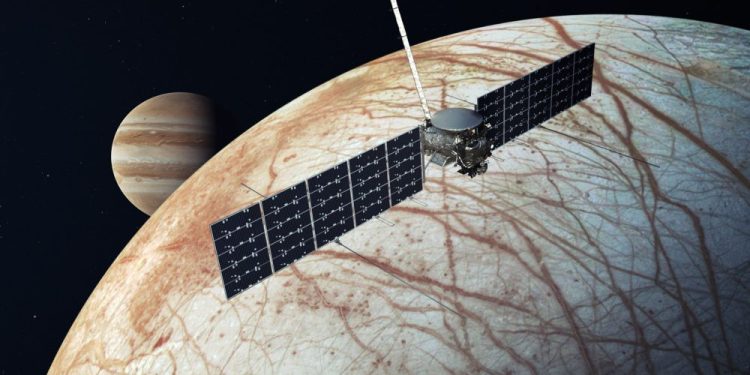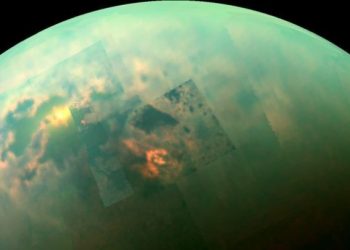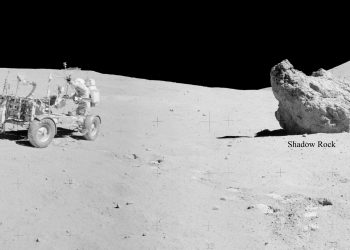Astronomers have long had the well-documented belief that an ocean of water is splashing beneath Europa’s ice crust. In recent research, scientists showed that there is enough heat in the bowels of Europa to keep part of the solid core in a molten state, and thereby support the existence of volcanoes on the ocean floor. This find suggests that the volcanic activity may be enough to support subsurface alien life on Jupiter’s moon.
10 Things you need to know about Europa’s hidden volcanoes and the potential existence of alien life
1. The main mechanism for the formation of this heat in the bowels of Europa is the tidal interaction of Europa with Jupiter itself, a phenomenon that occurs on other bodies of the solar system.
2. For example, on Io – another moon of Jupiter, known for its violent volcanic activity. As it rotates around Jupiter, Europa, primarily its rocky core, is constantly undergoing compression and stretching, which leads to the release of heat, just as a metal wire heats up if it is quickly bent and unbent.
3. In their study, the scientists thoroughly modeled the processes of heat release in Europa’s core, the dissipation of this energy, and the melting of the stone core, leading to volcanism and the existence of volcanoes.
This distinguishes it from Io, where volcanism on the surface has long been known and is beyond doubt – hundreds of active volcanoes, fueled by the tidal effect from Jupiter, spew lava and gases to an altitude of 400 kilometers.
4. However, Europa is farther from Jupiter, the tidal force on it is weaker, and astronomers were not sure if it was enough to warm its interior. Scientists led by Marie Behunkova from Charles University in the Czech Republic have calculated that the maximum volcanic activity should be observed in the region of the poles of Europa – at latitudes where the maximum tidal heat release occurs.
5. They also modeled the change in volcanic activity on the satellite over time during its evolution.
6. The interest in underwater volcanoes on Europa is due to the fact that on Earth volcanic activity proceeds in a very peculiar way and can affect biological diversity. When seawater on Earth comes into contact with hot lava spills, chemical energy is released. The energy of the eruption, not sunlight, helps to maintain life at great depths.
7. Therefore, in Europe, underwater volcanism may be the main source of energy supporting the simplest life forms, if they are present there.
8. The ocean lapping beneath Europa’s surface is currently viewed by many scientists as the most suitable candidate for the search for extraterrestrial life within the solar system. However, the ice, hiding the ocean from prying eyes, interferes with a detailed study of its composition.
9. Therefore, the satellite was chosen as the target of NASA’s Europa Clipper mission to reach it in 2030. It is planned that the device will make several dozen close flights over the satellite in order to investigate its internal structure and composition.
10. These data, coupled with the study of the chemical composition of the thin atmosphere, will help to understand how the exchange of matter between the ocean and the surface occurs, whether there is a trace of volcanic activity in the polar regions, and to confirm the hypothesis put forward.
Earlier, scientists showed that there is a mineral well known to earthlings on the surface of Europe – sodium chloride. And since the outer shell of the satellite is nothing more than a frozen ocean, the scientists concluded from this that it contains a large amount of salt, which makes this environment even more suitable for the theoretical detection of life in it.
To make such a discovery, scientists did not have to fly to a satellite to taste it – it turned out to be enough to analyze the light reflected from its surface. We will see what the Europa Clipper mission will find in the 2030s and whether it will confirm the existence of volcanoes or any volcanic activity on the satellite.
Join the discussion and participate in awesome giveaways in our mobile Telegram group. Join Curiosmos on Telegram Today. t.me/Curiosmos
Sources:
• Hartono, N. (2021, May 25). Europa’s Interior May Be Hot Enough to Fuel Seafloor Volcanoes. NASA.
• NASA. (n.d.). NASA’s Europa Clipper Builds Hardware, Moves Toward Assembly. NASA.
• Starr, M. (n.d.). Hints of Hidden Volcanoes Deep Inside Europa Boost Its Chances of Hosting Alien Life. ScienceAlert.
• Wall, M. (2021, May 26). Jupiter’s ocean moon Europa may have deep-sea volcanoes. Space.com.











